Expeditions: Ascension Island
Scientists from SISBIOTA MAR net in Brazil and California Academy of Sciences recently joined forces to study the
fish fauna of Ascension Island.
Ascension Island sits perched atop the mid-Atlantic Ridge, nearly equidistant from West Africa on one side and
Brazil on the other. Ascension’s sister island and closest point of comparison, both geographically and biologically,
is Saint Helena. At a distance of nearly 750 miles (1,200 kilometers), it’s the closest landmass in any direction.
There are other islands and archipelagos in the Atlantic, but they’re all farther away and none sits as far out to sea
as Ascension.
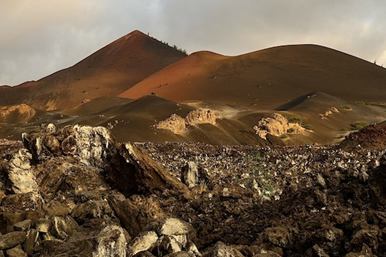
The cinder cones and basalt flows that dot the landscape here are a constant reminder of the island’s volcanic
origins. (Photo by Steven Bedard)
That isolation and the island’s relatively young age of 1.15 million years—by far the youngest of the tropical Atlantic
islands—have painted a peculiar biological and ecological picture. To start, this is a tremendously challenging
place for most species to reach. While large-bodied pelagic fish, like tuna and sharks, are able to make the trip as
adults, most reef fishes rely on hardy larvae, friendly currents and a boatload of luck to cross the thousand or so
miles of deep ocean from some distant coast before they can even hope to settle into suitable habitat here.
The odds are so poor, it’s astonishing any have managed to make the journey, but dozens have—nearly an equal
number of species from the west as from the east, including reefs as far away as the Indian Ocean. At present, the
number of successful colonizers sits at 108. Of these, 11 species are endemic, which means they’re found
nowhere else on Earth—it also means they’ve been here long enough to have evolved and differentiated from the
original gene pools from which they came.
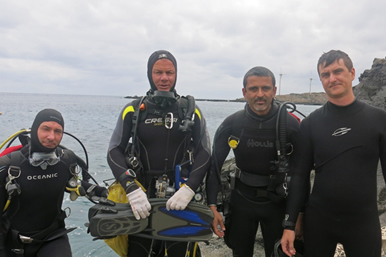
Divers ready to enter in water of English Bay. From left to right Steven Bedard (CalAcademy), Carlos Ferreira (UFF),
Luis Rocha (CalAcademy) e Sergio Floeter (UFSC).
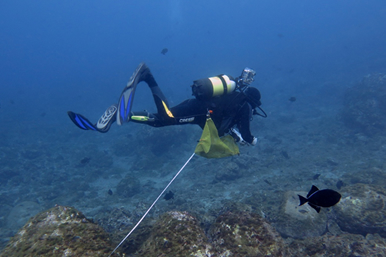
CELF running a visual census to estimate reef fish abundance.
Although Ascension has seen a fair number of these successful colonizations, the diversity here remains
remarkably low. To put this into perspective, the island has about one-tenth the number of fish species you’d find
within any similar-sized stretch of reef in the Coral Triangle of the Indo-Pacific. Only two other islands in the tropical
Atlantic have fewer coastal fish species than Ascension.
Still, as low as the diversity here is, the sheer number of fish is anything but. The nutrient-rich waters around
Ascension support a staggering abundance of bodies. On their very first dive, the team encountered breathtaking
schools of just some of the species that have made it here:surgeonfish and jacks, squirrelfish and
sergeant-majors, and one of Ascension’s best known species, the black triggerfish. At times, they were absolutely
surrounded by heavy, disk-shaped creatures, each one at least the size of a small plate, many much larger than
that. Rocha estimates that the density of fish here is 100 times what he saw during a recent trip to Bermuda. “It’s
hard to even get a good picture,” he says of his efforts to capture individual portraits of Ascension’s endemics.
“There’s always someone photo-bombing your shot.”
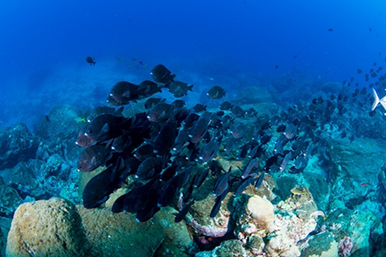
A school of sergeant-majors (Abudefduf saxatilis) on a mission as they mob-feed through the reef.
(Photo by Luiz Rocha)
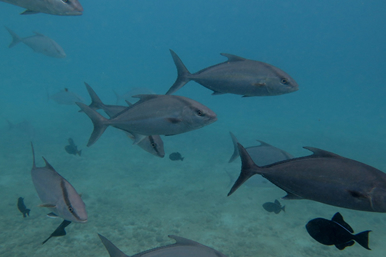
Schools of amberjack and other carangids are still abundant around Ascension (photo by CELF).
While many of the species here are found elsewhere, the scientists suspect the fish have likely found a wealth of
open niches around Ascension—foods, breeding habitats and hiding places that would have been filled by any
number of other species where they evolved. There might simply be an abundance of opportunity here, particularly
for generalists or fish capable of a greater degree of plasticity in terms of behavior and food choices. The fact is, no
one really knows. Aside from the basic list of ingredients—the age of the island, its location, size and the number of
species that have managed to colonize the place—no one knows much about Ascension Island’s marine
ecosystem. Where many of these fish came from, how long they’ve been here, and exactly how they’re making a
living in this remote place is a mystery. That’s why these scientists have waited so long to come to Ascension, and
why they’re so happy to be here now.
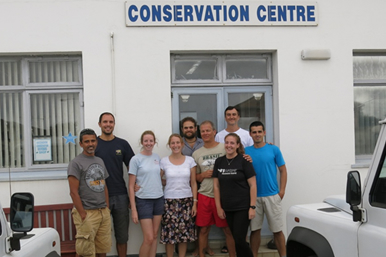
Brazilian and American scientists were locally supported by scientists from the Conservation Centre, based in
Georgetown, Ascension.
Written by: Steven Bedard
Ascension Expedition 2015 |















